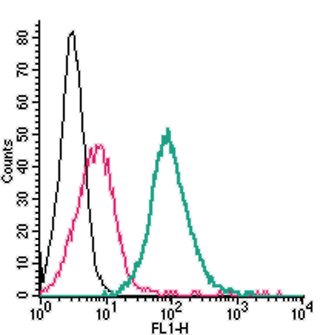Overview
- Peptide (C)GKPPSVVSWETRLK, corresponding to amino acid residues 177-190 of human Nectin-1 (Accession Q15223). Extracellular, N-terminus.
 Cell surface detection of Nectin-1 by direct flow cytometry in live intact mouse J774 macrophage cells:___ Cells.
Cell surface detection of Nectin-1 by direct flow cytometry in live intact mouse J774 macrophage cells:___ Cells.
___ Cells + Rabbit IgG isotype control-FITC.
___ Cells + Anti-Nectin-1/PVRL1 (extracellular)-FITC Antibody (#ANR-051-F), (2.5µg). Cell surface detection of Nectin-1 by direct flow cytometry in live intact human MEG-01 megakaryocytic leukemia cells:___ Cells.
Cell surface detection of Nectin-1 by direct flow cytometry in live intact human MEG-01 megakaryocytic leukemia cells:___ Cells.
___ Cells + Rabbit IgG isotype control-FITC.
___ Cells + Anti-Nectin-1/PVRL1 (extracellular)-FITC Antibody (#ANR-051-F), (5µg). Cell surface detection of Nectin-1 by direct flow cytometry in live intact human THP-1 monocytic leukemia cells:___ Cells.
Cell surface detection of Nectin-1 by direct flow cytometry in live intact human THP-1 monocytic leukemia cells:___ Cells.
___ Cells + Rabbit IgG isotype control-FITC.
___ Cells + Anti-Nectin-1/PVRL1 (extracellular)-FITC Antibody (#ANR-051-F), (2.5µg).
Nectins, which were originally identified as virus receptors, are members of the cell-cell adhesion molecule (CAM) family. They are Ca2+-independent immunoglobulin-like CAMs. The nectin family comprises four members, nectin-1, nectin-2, nectin-3 and nectin-4, which are encoded by the PVRL1, PVRL2, PVRL3 and PVRL4 genes, respectively1. In the central nervous system, these cell adhesion molecules aggregate in formations, termed puncta adherentia junctions, which are mechanical adhesive sites that connect pre- and postsynaptic membranes2.
All nectins contain an extracellular region with three immunoglobulin-like loops (one V type and two C2 types), a single membrane-spanning region and a cytoplasmic tail. Nectins directly bind afadin, an F-actin-binding protein, through their cytoplasmic tails1.
Nectin-1 is expressed at cell-cell junctions in human and mouse epidermis. In mice lacking the gene encoding nectin-1 (Pvrl1−/− mice), the expression of loricrin, a differentiation marker and a major component of cornified cell envelopes in the epidermis, is downregulated and newborn pups have a shiny and slightly reddish skin3. Mutations in human PVRL1 are implicated in cleft lip or palate-ectodermal dysplasia syndromes, which includes Zlotogora–Ogur syndrome and Margarita Island ectodermal dysplasia4. Both of these are autosomal recessive disorders that are clinically characterized by unusual facial appearance, dental anomalies, hypotrichosis, palmoplantar hyperkeratosis and onychodysplasia, syndactyly, cleft lip or palate, and in some cases, mental retardation5.
